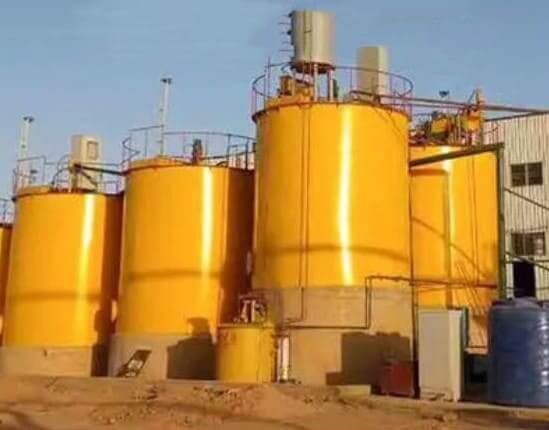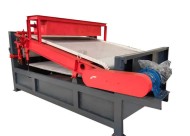CIL (Carbon in Leach) is a widely used method for extracting gold from ore. It is a metallurgical process that involves the dissolution of gold particles into a cyanide solution and their subsequent adsorption onto activated carbon. Mining operations commonly employ this process to recover gold from low-grade or refractory ore.
CIL Principle
- Leaching: The gold ore is crushed and ground to a fine powder. It is then mixed with a cyanide solution, usually sodium cyanide, to create a slurry. The cyanide solution reacts with gold in the ore, forming soluble gold-cyanide complexes.
- Adsorption: The cyanide-gold solution is passed through activated carbon adsorption tanks. The activated carbon has a high surface area and a strong affinity for gold ions. It adsorbs the gold-cyanide complexes from the solution, effectively concentrating the gold.
- Elution: After the carbon has adsorbed a significant amount of gold, it is removed from the adsorption tanks and subjected to elution. In elution, the carbon is treated with a hot, concentrated cyanide solution to strip the gold from the carbon.
- Electrowinning: The gold-cyanide solution obtained from elution is then subjected to electrowinning. This process uses an electric current to plate the gold onto cathodes.
- Smelting: Alternatively, the gold can be recovered by smelting the gold-rich concentrate, producing gold bars or bullion.
CIL Advantages
- High Gold Recovery: CIL has high gold recovery rates, making it suitable for low-grade and complex ore types.
- Efficient Adsorption: Activated carbon efficiently adsorbs gold, allowing for effective gold concentration.
- Versatility: CIL can be adapted to various ore types and processing conditions.
- Cost-Effective: CIL is often more cost-effective than gold extraction methods like CIP (Carbon in Pulp).
- Environmental Considerations: Modern CIL processes are designed with environmental considerations in mind, minimizing the release of cyanide into the environment.
CIL Process
- Crushing and Grinding: The gold ore is crushed into a fine powder.
- Cyanide Leaching: The ground ore is mixed with a cyanide solution to dissolve the gold.
- Adsorption: The gold-cyanide solution is passed through activated carbon to adsorb the gold.
- Elution: The loaded carbon is subjected to elution to strip the gold from the carbon.
- Electrowinning or Smelting: The gold is recovered either by electrowinning or smelting, depending on the chosen recovery method.
- Refining: The recovered gold is further refined to produce high-purity gold.
The CIL process is a proven and widely used method for gold extraction, with its efficiency and adaptability making it a popular choice in the mining industry. However, following safety and environmental guidelines when employing this process is important.

CIL Processing Line Chemicals List
CIL (carbon in leaching) processing lines for gold mines usually require chemicals to extract and process the gold ore. The following is a list of chemicals commonly used on CIL treatment lines:
- Sodium Cyanide (NaCN)
The primary agent used to dissolve gold and silver. - Oxidizing agent (e.g., oxygen or hydrogen peroxide)
Use the oxidizing agent with sodium cyanide to promote oxidation and dissolution of gold. - Lime (CaO)
Use lime to adjust the pH of a solution to maintain proper alkaline conditions. - Sodium Hydroxide (NaOH)
Use sodium hydroxide to adjust pH and maintain alkaline conditions. - Sodium hypochlorite (NaClO)
Use sodium hypochlorite to oxidize gold and silver and promote their dissolution. - Activated carbon
Use activated carbon to adsorb gold and silver ions for subsequent reduction and recovery. - Polyacrylamide (PAM)
Use polyacrylamide to improve the effect of solid-liquid separation. - Sulfuric acid (H2SO4)
Use sulfuric acid in some cases to adjust the acidic conditions of a solution. - Ammonia (NH3)
In some cases, use ammonia to adjust the alkaline conditions of a solution. - Clarifier
Use a clarifier to remove suspended solids and impurities. - Redox Agent
Use redox agents to reduce gold and silver, causing them to precipitate into metals. - Chelating agents
Use chelating agents to increase the solubility of gold and silver so extract them more easily. - Dissolution Aid
Use dissolution aid to help speed up the dissolution of gold and silver. - Anti-foaming agent
Use an anti-foaming agent to control foam generation to maintain the treatment process’s stability.
Chemicals & Dosage List for 300TPD CIL Plant
- Dosage of activated carbon
Add carbon at a rate of 10-15 g/L. After adding, prepare 3 tons more. Activated carbon can be recycled after pickling washing.
The first leaching tank in the CIL plant does not need carbon, and the 7 adsorption tanks add carbon. The volume of one adsorption tank is 98 cubic meters, 98*7=686 cubic meters, calculated based on 13 grams/liter, 686 cubic meters*13=9 tons of carbon, prepare 3 tons of extra carbon, a total of 12 tons carbon will be enough for one year.
- Dosage of sodium cyanide (30% liquid sodium cyanide)
Calculated based on 1kg/ton of ore, the specific dosage is investigated according to the silver nitrate titration results, and the concentration of free sodium cyanide is maintained at 0.03% – 0.05%.
- Lime dosage
Calculated based on 1kg/ton of ore, the pH value should be controlled to about 10.5.
- Dosage of flocculant
Calculated at 30 g/ton of ore, the CIL plant requires approximately 9 kg of flocculant per day.
- Electrolyte solution
Sodium hydroxide 40kg
Sodium cyanide 80kg
Electrolyte solubility: sodium hydroxide 1%, sodium cyanide 2%After each batch of electrolysis, test the concentration of sodium hydroxide and sodium cyanide in the solution. If there is less, add cyanide or sodium hydroxide.
- Dosage of hydrochloric acid
Hydrochloric acid is used when carbon is washed after electrolysis. It is made into a 5% solution, about 30 kilograms at a time. Normally not used, only used when cleaning carbon.
- Total water consumption (clean water + circulating water)
Calculated based on 1.5 tons of water/ton of ore, the leaching concentration is guaranteed to be 40-45%. The backwash water of the centrifugal concentrator needs to be calculated in addition to 80 tons of water/hour. So the CIL plant requires 450 tons of water/day + 80 tons/hour of backwash water from the centrifugal concentrator.
LATEST PRODUCTS
-
Tubular Screw Conveyor
【Capacity】6-50 m3/h 【Procesible Material】 …
-
Heavy Plate Feeder
Capacity: 100-240 m3/h Power: 15-45 kW Speed: 0…
-
Plate Magnetic Separator
【Capacity】8-35 t/h 【Power】1.5-3 kW 【Applic…









